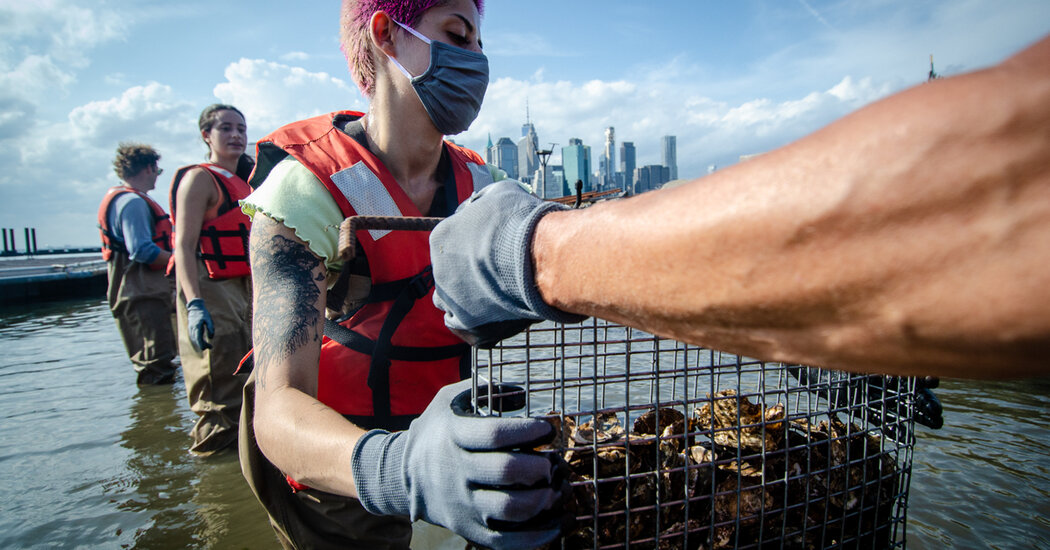
Oysters, a vital food crop harvested from New York Harbor long before European oysterlovers arrived, all but disappeared about 100 years ago, done in by overfishing and pollution. Now the bivalves are coming back; there are signs that they’re starting to regenerate in some of the local oyster beds, thanks to an initiative, the Billion Oyster Project, that began in 2014. A billion oysters in New York Harbor? That’s the goal by 2035 for the largely volunteer organization helped by restaurants and shops donating empty shells. Oysters not only filter water to improve quality but the shells capture carbon dioxide, doing their part to reduce global warming. Next month the project will benefit from a huge party with oysters from many American producers to sample — but none from the Harbor; they’re not yet fit to eat, though many from surrounding Long Island, Connecticut, Rhode Island and New Jersey waters will be available. Chefs will also serve seafood specialties and there will be local wines and beers.
Billion Oyster Party, 6 p.m. to 11 p.m., Sept. 22, Navy Yard Building 269, Second Street (Morris Avenue), Dumbo, Brooklyn; tickets, $500 for V.I.P. starting at 6 p.m., $200 for general admission after 8 p.m., billionoysterparty.org.
Fancy Wine Glasses at Half the Price
A new collection, GV Home, includes impressive pieces, some with the skinniest of stems, from $25 to $50 per glass, about half of what most luxury glassware costs. David Kong, an entrepreneur and oenophile, has brought fine handblown lead-free crystal stemware to tables in restaurants, and now homes, at more moderate prices by eliminating the middlemen and selling directly. There’s a well-designed universal wine glass along with several others meant to show wines with particular characteristics like minerality and big bouquets. The Champagne glass, a rounded tulip, is excellent. The glasses are dishwasher safe but most are about nine inches tall, something to take into account for storage or display. The glassware is also labeled “natural”; we have enough trouble defining “natural” wines, and now wine glasses?
Glasvin stemware and barware, $25 and up, glasvin.com.
A Cookbook That Gives Haggis Its Due
When the book is by Scotland’s national chef, Gary Maclean, you can count on recipes for cock-a-leekie, kedgeree, cullen skink (smoked haddock chowder), Dundee cake and an entire chapter devoted to haggis. “The Scottish Kitchen” also features modern takes, like grilled lobster with warm tomato and basil salsa; pearl barley with roasted carrots; and pheasant with mushrooms, pearl onions and tarragon, a braised dish that accepts chicken nicely. The Scottish sweet tooth is on full display in this handsomely photographed volume with shortbread, oven scones, oakcakes and a superb rice pudding. The chef tells you how to prepare but not how to pronounce dishes like forfar bridie and bradan rost. The book is worth reading for his historical tidbits and personal connections to the food.
“The Scottish Kitchen: More Than 100 Timeless and Contemporary Recipes from Scotland” by Gary Maclean, National Chef of Scotland (Appetite by Random House, $30).
An Easier Way to Try Ancient Wine Styles From Georgia
The country of Georgia is probably justified in taking credit for having been the birthplace of wine. Indeed, in recent years, winemakers have studied and sometimes incorporated its ancient methods, like fermentation in clay jars called qvevri. In 2020, Adalbert Yanick Arakelov, an American who was born in Tbilisi, his business partner Barry Greer and other investors, started Silk Road to import Georgian wines, made with both modern and ancestral styles using native grapes and European vinifera. The bottles are from different wineries, though all are said to be natural and are labeled Silk Road. The full range, worth exploring, is now available in the United States. Amber qvevri wines from grapes like rkatsiteli and khikhvi were somewhat challenging and funky, hinting of dried fruit; a dark rosé was pleasant well-chilled. Dry reds made with the saperavi grape included a nice everyday unoaked red and a full-bodied, complex reserve aged eight months in oak.
Silk Road Wines, $13.99 to $45, silkroadwines.com.
The Fashionable Art of the Nosh
Jake Cohen, a food writer best known for his intricate and imaginative interpretations of challah and other foods, takes on noshing (or as non-Jews might have it, snacking) in his latest book, “I Could Nosh: Classic Jew-ish Recipes Revamped for Every Day.” On Sept. 12 at Temple Emanu-El he will banter about his relationship with Jewish foods with the designer and performer Isaac Mizrahi, no slouch himself when it comes to entertaining repartee.
Jake Cohen in Conversation With Isaac Mizrahi, Sept. 12, 6:30 p.m., $35 including a copy of the book ($40 shipped for virtual attendees), $99 premium seating and reception; the Temple Emanu-El Streicker Center, 1 East 65th Street, 212-507-9580, streicker.nyc.
New Mackerel for Your Summer Salads
There’s some new competition for high-end tuna in jars. Two kinds of wild Sicilian mackerel — sgombro, or small mackerel, and sugarello horse mackerel fillets packed in extra virgin olive oil — are now being imported. They’re both pale in color and mildly flavored. The sgombro has a softish texture; the sugarello is firmer and somewhat meatier. Your salade niçoise, summery pasta with chopped fresh tomatoes or antipasto of confit fish with white beans will never be the wiser. They beg for a shower of capers, and loosened purse strings.
Testa Filetti di Sgombro, Filetti di Sugarello, $25 for 10.2 ounces, gustiamo.com.
Follow New York Times Cooking on Instagram, Facebook, YouTube, TikTok and Pinterest. Get regular updates from New York Times Cooking, with recipe suggestions, cooking tips and shopping advice.



